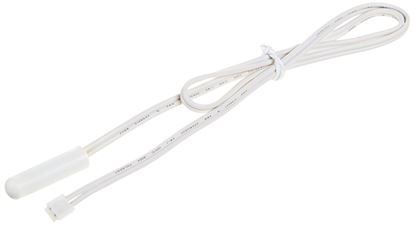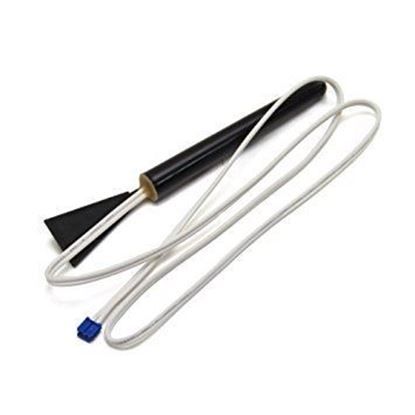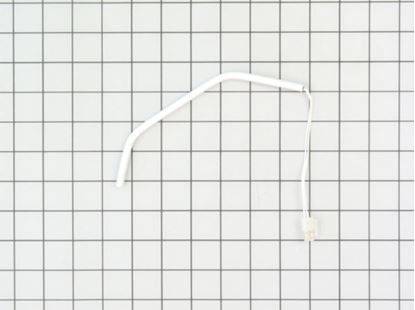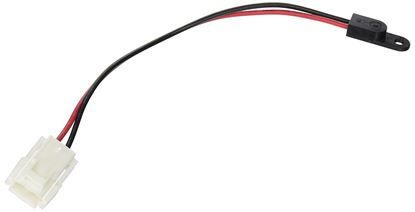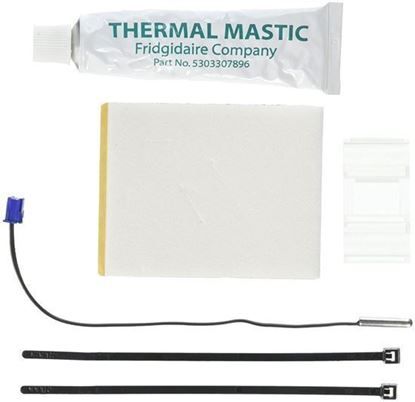
How to Diagnose Refrigerator Thermistor Issues Like a Pro
A refrigerator thermistor plays a critical role in keeping your refrigerator running efficiently. This small but essential component monitors temperature changes and sends signals to the control board, helping your fridge maintain consistent cooling. When the sensor thermistor fails, it can lead to problems such as inconsistent cooling, spoiled food, or a constantly running compressor.
Knowing how to test a thermistor on a refrigerator helps homeowners identify the root cause of temperature fluctuations and avoid unnecessary part replacements. This guide walks you through everything, from understanding what a refrigerator thermistor does, identifying the symptoms of a bad refrigerator thermistor, testing the component, and replacing it if necessary, to preventing future issues for long-lasting refrigerator performance.
What is a Refrigerator Thermistor and Why It Matters
A refrigerator thermistor is a temperature-sensitive sensor that monitors the internal temperature of your fridge and sends feedback to the main control board. This feedback determines when the compressor should turn on or off to maintain the correct cooling level.
-
The refrigerator thermistor acts as the “temperature sensor” of your appliance, helping it maintain optimal cooling performance.
-
In models like the Frigidaire refrigerator temperature sensor, this part ensures precise temperature control for both the freezer and refrigerator compartments. If the readings from the thermistor are inaccurate, your fridge might cool too much, too little, or run continuously.
Knowing the Frigidaire refrigerator temperature sensor location makes troubleshooting and replacement easier when issues arise.
Common Signs Your Thermistor is Failing in Your Refrigerator
Detecting the symptoms of a bad refrigerator thermistor early helps prevent food spoilage and energy waste. Here are the most common signs that your sensor thermistor may be going bad.
-
Inconsistent cooling: If some areas of your fridge are too cold while others stay warm, it’s a classic sign of a faulty thermistor.
-
Compressor running constantly: When the refrigerator thermistor fails to sense the correct temperature, the compressor may run continuously, increasing energy bills.
-
Temperature display errors: Digital refrigerators may show incorrect readings or flashing error codes if the Frigidaire refrigerator temperature sensor is malfunctioning.
-
Frost buildup: A faulty thermistor can cause the evaporator to overfreeze due to incorrect temperature signals.
-
Spoiled or frozen food: When your refrigerator thermistor misreads temperatures, it can cause food to freeze or spoil too quickly.
These symptoms of a bad refrigerator thermistor often indicate that it’s time for testing or replacement to restore proper operation.
Tools You Need for Refrigerator Thermistor Diagnosis
Having the right tools ensures accurate results when testing your Refrigerator Thermistor.
-
Digital multimeter: The most important tool for measuring the resistance (ohms) of the sensor thermistor.
-
Screwdriver set: Helps you remove interior panels to reach the Frigidaire refrigerator temperature sensor location.
-
Replacement thermistor: Have a new refrigerator thermistor ready in case your current one tests defective.
Once you have these tools, you’re ready to start diagnosing your faulty thermistor and bringing your refrigerator back to optimal performance.
Step-by-Step Process to Test Your Refrigerator Thermistor
Testing the refrigerator thermistor is a straightforward process if you follow the right steps. This section explains exactly how to test a thermistor on a refrigerator using simple tools and accurate methods.
-
Unplug the refrigerator: Always begin by disconnecting power. Working on electrical components while plugged in can cause shock or damage to the sensor thermistor.
-
Locate the thermistor: Check the Frigidaire refrigerator temperature sensor location, it’s typically mounted on the back panel of the fridge compartment or attached to the evaporator coil.
-
Access the thermistor: Use a screwdriver to remove the interior panel and carefully expose the Refrigerator Thermistor.
-
Disconnect the sensor: Gently unplug the sensor thermistor connector from the control wiring harness. Make sure to note how it’s connected for reassembly later.
-
Test resistance with a multimeter: Set your digital multimeter to the “ohms” setting. Connect each probe to the two terminals of the Refrigerator Thermistor. At room temperature (around 77°F), most thermistors should read approximately 8,000–10,000 ohms. If the reading is significantly higher or lower, you may have a faulty thermistor.
-
Perform an ice-water test: Place the sensor thermistor in a glass of ice water (32°F) and retest. The resistance should increase (typically around 25,000 ohms). If it doesn’t change, the refrigerator thermistor is defective.
-
Reassemble the refrigerator: Once testing is complete, reconnect the sensor thermistor and reattach the panel. Plug the refrigerator back in and check whether cooling cycles stabilize.
Following this process helps homeowners confidently identify whether their refrigerator thermistor is the cause of the problem.
How to Diagnose and Fix Refrigerator Wire Harness Problems for Reliable Cooling
How to Fix or Replace a Faulty Thermistor in Your Refrigerator
When testing confirms a faulty thermistor, replacement is usually the simplest solution. Swapping out a damaged refrigerator thermistor ensures accurate temperature regulation and restores efficient operation.
-
Disconnect power: Safety comes first, unplug the refrigerator before working with electrical components.
-
Locate the old thermistor: Refer to the Frigidaire refrigerator temperature sensor location guide in your manual. Most models have it attached to the evaporator coil or rear interior wall.
-
Remove the old thermistor: Unscrew or unclip the defective sensor thermistor carefully. Inspect the area for moisture, frost buildup, or damaged insulation.
-
Install the new thermistor: Place the new refrigerator thermistor in the same position and secure it firmly. Correct placement ensures accurate temperature readings.
-
Reconnect wiring: Attach the connector firmly and check for tight, corrosion-free electrical contacts. Loose wires can cause similar symptoms of a bad refrigerator thermistor, even if the sensor itself is fine.
-
Power up and test: After assembly, plug the fridge back in. Observe if cooling performance returns to normal. If the compressor cycles on and off correctly, your repair was successful.
By understanding how to test a thermistor on a refrigerator and replace it properly, you can avoid costly technician visits and maintain consistent cooling performance.
Preventive Tips to Avoid Future Refrigerator Thermistor Problems
Regular maintenance helps extend the life of your refrigerator thermistor and keeps your appliance efficient. Implementing these tips can prevent another faulty thermistor from developing in the future.
-
Clean regularly: Wipe down the refrigerator interior and ensure no moisture or dirt collects around the Frigidaire refrigerator temperature sensor location. Contaminants can affect temperature readings.
-
Inspect door seals: Damaged seals allow warm air to enter, forcing the compressor to overwork and leading to misleading data for the Refrigerator Thermistor.
-
Defrost when necessary: Frost buildup around the sensor thermistor can interfere with accurate temperature detection. Periodic defrosting keeps readings consistent.
-
Check wiring connections: Loose, corroded, or frayed wires can mimic symptoms of a bad refrigerator thermistor even when the sensor itself is fine. Regular inspection ensures reliability.
Preventive care not only reduces breakdowns but also ensures the Frigidaire refrigerator temperature sensor maintains steady temperature control and optimal energy performance.
9 Refrigerator Problems & Proven Fixes You Need to Know: troubleshooting refrigerator problems
Understanding the importance of a refrigerator thermistor is key to maintaining a reliable and efficient refrigerator. By learning how to test a thermistor on a refrigerator, homeowners can confidently diagnose whether they have a faulty thermistor or a wiring issue. With regular maintenance and preventive checks, your refrigerator thermistor will continue to perform reliably, extending the life of your appliance and ensuring consistent performance for years to come. HnK Parts offers high-quality refrigerator parts & accessories, from motors to compressors and gaskets to door seals, compatible with top brands such as Whirlpool, LG, and Samsung.
FAQs
What are the symptoms of a bad thermistor?
A bad refrigerator thermistor causes incorrect temperature readings, leading to cooling issues, inconsistent temperatures, or the compressor running continuously.
What are the two suggested ways to check a thermistor?
To check a refrigerator thermistor, use a multimeter to measure resistance at different temperatures or inspect it for physical damage or corrosion.
Why is my refrigerator not cooling after replacing the thermistor?
If the refrigerator is not cooling after replacing the thermistor, it may be due to an incorrect installation, faulty wiring, or a malfunctioning control board.


